Cultural-Linguistic AAC Intervention: Gathering Information from Families with Questionnaires and Surveys
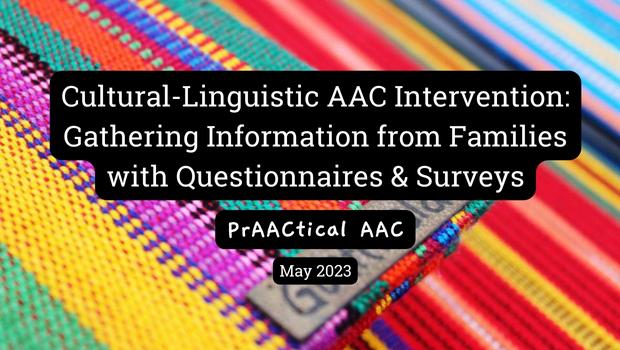
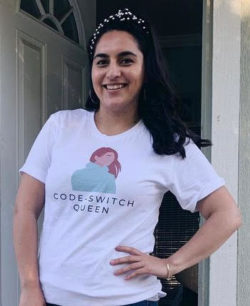 We are pleased to publish the third post in a series on multilingual AAC support guest authored by BilingüeAAC. BilingüeAAC is a group of SLPs with a shared belief in providing evidence-based intervention strategies and resources to bilingual Spanish AAC clients, families, caregivers, and professionals. In today’s post, guest author Alma Partida discusses the relevance of getting family input and share a helpful resource that can be used by clinicians, teachers, and others working with bilingual and multilingual clients.
We are pleased to publish the third post in a series on multilingual AAC support guest authored by BilingüeAAC. BilingüeAAC is a group of SLPs with a shared belief in providing evidence-based intervention strategies and resources to bilingual Spanish AAC clients, families, caregivers, and professionals. In today’s post, guest author Alma Partida discusses the relevance of getting family input and share a helpful resource that can be used by clinicians, teachers, and others working with bilingual and multilingual clients.
If you are new to this series, you can check out the first two articles using the links below.
- Bilingual AAC Support from Monolingual Professionals: An Introduction, here.
- Cultural-Linguistic AAC Intervention: A Framework for Consideration
Family Questionnaire and Culture Survey
We are continuing our Bilingüe AAC posts (check out post #1 and post #2) with a topic that is important to consider when working with multilingual AAC families.
Conducting a family questionnaire is essential for working with any family and any language. However, for bilingual families a family questionnaire and culture survey is imperative as it will help with implementation as well as gauge their buy-in for using AAC.
One of the research articles we enjoy quoting is Soto and Yu 2014- Considerations for the Provision of Services to Bilingual Children Who Use Augmentative and Alternative Communication. Found here
One of the most compelling quotes from that article was:
- “When culturally diverse families expressed barriers to AAC they mentioned: a) language intervention only in the school language; b) language and cultural barriers between parents and professionals; c) communicative limitations of the AAC device; d) irrelevant vocabulary; e) culturally inappropriate symbols and messages and f) lack of culturally and linguistically accessible, family-centered instruction of how to use the device.”
Thus, we at Bilingüe AAC created the Spanish Parent Questionnaire for AAC because we couldn’t find a product that addressed what we needed for working with our multilingual families. The product can be found on our Website shop here.
Questions for Parents
Another important quote from that aforementioned article:
- “Instead of assuming that AAC, will be helpful to our family, professionals should ask the parents about communicative situations in which they wish their child could participate and target those situations as contexts for intervention”
This is the main reason we created the questionnaire! It is meant to help address in which contexts the AAC would be helpful to augment what our student is already using!
- Our questionnaire asks:
- What are some words/social routines that are engaged in the morning
- What are some words/social routines that are engaged with in the evening
- What are some words/social routines related to special holidays
- Etc!
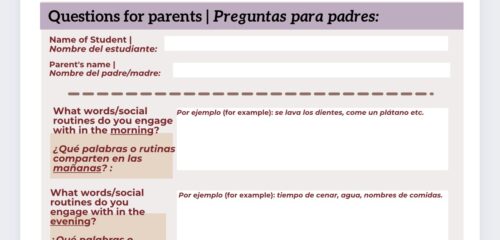 Vocabulary Inventory
Vocabulary Inventory
We also address the bullet point “d)” that multilingual families reported as a hindrance to AAC use: irrelevant vocabulary. Understanding which words they would like to use as a family is important to address, “irrelevant vocabulary “ (Soto & Yu, 2014). In our questionnaire we included various categories such as:
- Food Words
- Beverages
- Holiday/Religions
- People
- Etc!
This will help not only personalize the device but engage them in wanting to use the device since it will have relevant vocabulary that is engaging to that particular family!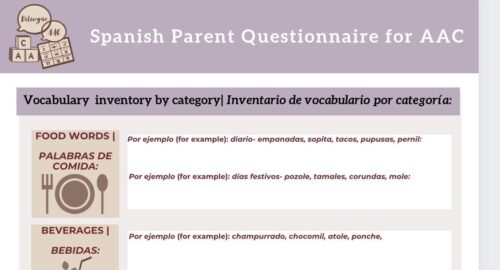
Checking our Cultural Bias
ASHA has many ways to check our cultural bias, which is highly recommended before implementing this questionnaire. The first thing we think of is giving this questionnaire to the family to have them fill it out. Unfortunately, for multilingual families, it is important to gauge family literacy before we send them a 4-5 page questionnaire like this. Engaging in an informal interview, instead of asking the family these questions via question and answer format will provide you with more information. The use of a translator or interpreter is highly recommended. Please move away from using a sibling or other family member as an interpreter/translator.
The questionnaire should be:
- Filled out WITH the family
- Explained to the family as to the importance of it
- Used with a translator/interpreter present
- Not asked in a question-and-answer format, instead as part of an informal interview
- Explain to parents that this is part of a fluid assessment process, meaning the vocabulary will change
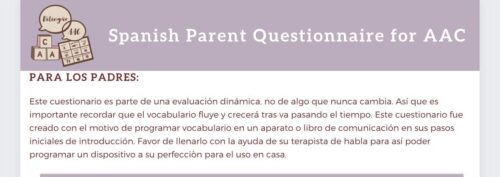 Why is this important?
Why is this important?
Imagine perfecting a 14-page speech-generating device funding report, complete with extensive trials and a long wait for feature matching of all the vocabulary sets. All of that hard work!!
For a device to then be abandoned because it is not used at home. Why? Because the family does not see themselves represented and because they were not involved in the process of assessment for the device.
This is why a questionnaire is important!! You learn from the get-go what a family’s familiarity with AAC is, and you can teach them the power of having the client/student find their voice. You must also complete the questionnaire as part of an ongoing assessment process even after a device has been picked. Helping the family identify how it is going, what is working, and what is not working, and thus adding/removing vocabulary as needed. It may seem like an intense process, but you will save so much time by addressing right from the beginning their understanding of AAC.
About the Guest Author
A lma M. Partida is a bilingual and bicultural Speech-Language Pathologist specializing in AAC. Alma graduated from San Jose State with her Bachelor’s in Communicative Sciences and Disorders and a minor in Psychology. She completed her graduate studies at San Jose State where she received the Project AACes grant. She currently practices as an SLP and AAC consultant in Northern California with preschool and early elementary-aged students. She is also a community partner and lecturer at CSU-Monterey Bay. Alma manages the Instagram accounts @AACForYouandMe and @DiverseAAC.
lma M. Partida is a bilingual and bicultural Speech-Language Pathologist specializing in AAC. Alma graduated from San Jose State with her Bachelor’s in Communicative Sciences and Disorders and a minor in Psychology. She completed her graduate studies at San Jose State where she received the Project AACes grant. She currently practices as an SLP and AAC consultant in Northern California with preschool and early elementary-aged students. She is also a community partner and lecturer at CSU-Monterey Bay. Alma manages the Instagram accounts @AACForYouandMe and @DiverseAAC.
Filed under: Featured Posts
This post was written by Carole Zangari
